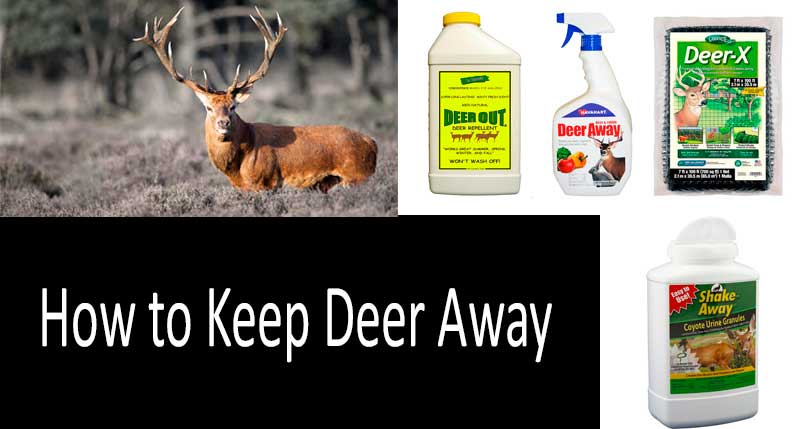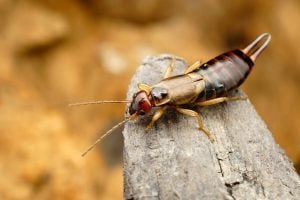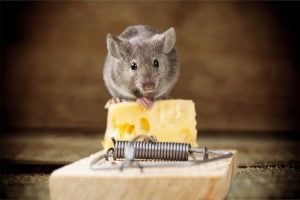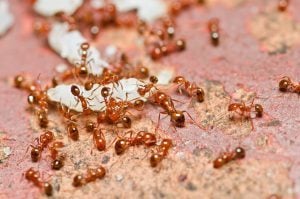Being a part of the wildlife, deer are pleasant to look at, but these cute animals become a grave issue for gardens and gardeners. Spoiled crops and damaged bushes and chewed flower beds can be a punishment for carelessness with deer being to near your house. Moreover, deer can be disease carriers for borreliosis, which is dangerous to humans and is transmitted through mites hidden in their skin, and livestock and horses can get infected by deer with such diseases as EHD. All these arguments are in favor of developing your own plan on how to keep deer out of the garden using proper deer control products. You will find out what the scientists have to say and how high deer fencing or deer netting should be used and how to properly install it.
Contents
- Ways To Keep Deer Out Of Your Garden
- Comparison Of The Effectiveness Of 9 Best Ways To Keep Deer Away
- What You Need To Know About Deer Behavior
- How To Avoid Deer Road Accidents
- TOP-8 Deer Fencing, Netting And Other Products To Protect Your Garden
Ways to Keep Deer Out Of Your Garden
White-tailed deer are widespread in North America, and their number is particularly high in suburban areas. These animals adapt easily to different habitats. Restricting hunting, reducing the number of wild predators and increasing the amount of abandoned farmland only made it easier for them. Regular deer invasion can be controlled with various methods.
Habitat Modification
Deer habitat is not limited to wildlife, but also includes towns and farmland. You can try modifying these animals’ habitat by making your land less attractive to them. For example, you can remove the bushes making them feel unsafe or plant something they don’t feed on.
Michael Anthony Foster, UGA Extension, claims that habitat modification is more effective for protection of wild flowers and plants than for fruits and vegetables. Plenty of plants will make your garden just as beautiful, yet less attractive for the deer. However, even in this case, there will not be a full guarantee of the integrity of plantings.
Which Plants Deer Love
Here is a list of some of deer’s favorite plants, that you definitely should not plant if you don’t want a frustrating up-hill battle! Their best winter treats are evergreen shrubs, such as cedar, and yew tree. Deer are especially fond of tender green plants and shrubs. They are attracted by geranium, tulips, roses, azalea, clover, holly and elder. These animals do not mind eating nuts, fruits, especially apples, strawberries, cherries and persimmons. And, of course, vegetable harvest, especially potatoes, salad greens, beans, broccoli, wheat all of which attract deer to your garden.
Which Plants Deer Hate
It will be wise to plant something deer clearly dislike, such as plants with coarse, ferny leaves, or with a strong smell and stiff thorns. In addition, the list of the food deer detest, in particular, includes Byzantine purifier, hellebore, catnip, lavender and wormwood. Although deer adore tulips, they avoid other bulbous plants, such as narcissus. Perhaps you should favor equally beautiful, but so unloved by deer narcissus?
University of Illinois college of Agriculture, Consumer and Environmental Sciences educator, Andrew Holsinger, believes that the damage can be significantly reduced if you sow proper plants and vice versa. “If homeowners have a selection of plant species that are favored by deer, they can expect frequent dinner guests in their garden… Often, some ornamental plants used in landscaping are preferred because they are fertilized and irrigated, making them nutrient-rich and moist,” notes Andrew Holsinger.
Which Deer Fencing Should You Use?
If you are looking for a long-term effect, create an artificial barrier or use an electric railing to fence off deer. Fences can be as small as a flower bed or as large as a farm and made of plastic, metal or wood.
One thing you need to remember is that it only makes sense to fence if it will fully banish deer from your lot and they will have no entrance. In any other case, deer will sooner or later figure out by trial and error that it is possible to overcome the barrier. Once a deer overcomes an insecure barrier and gets inside, and you, unaware, close the gate, the trapped animal will panic and cause the most disastrous consequences for your garden.
Metal fences can be used even in places where there are too many deer. Such fencings are expensive and difficult to install but are easy to maintain. Electric fences have several benefits: they are affordable, they train deer through pain and can either be installed temporarily or permanently. The advantage of vertical electric fences is that they can be installed in places where high fences cannot be set. Electric fencing height varies from 5 to 10 feet. An inclined wired fence installed at an angle of 30º from the ground is a yet another popular type of fencing. Its design is 3D, therefore it takes up more space, but an inclined fence is more effective than a vertical one. The reasons for that are deer’s poor depth perception and the fact that obviously it is far more difficult to jump over.
Scaring
You can install a sensor device that will spray it with water or turns on the light once it detects deer motion. Another device, an acoustic gadget, will scare deer for the time being until you face the problem: these noises will equally affect other animals inhabiting the lots. Does that work for you? Moreover, scaring is temporary, as deer get used to such inconveniences quickly.
Hunting
Selective deer shooting is a short-term control method. Moreover, it cannot be used in many rural areas with hunting restrictions. Be sure to check your local hunting and trapping regulations before pursuing this method.
5 Rules to Keep Deer Away
Keep in mind these simple rules that will help you fence off the unwanted guests.
- If you are going to plant fruits and vegetables loved by deer, locate them as close to your house as possible.
- Plant large evergreen trees along the perimeter of the garden so that the deer don’t see any potential treats (they dislike evergreen plants).
- Create deer barriers as they are poor alpinists. Dig deep flower beds and make embankments.
- Hang deer netting over the bushes, fruits and around the trees. Netting is softer than wiring and will thus easily surround uneven surfaces and fill any voids.
- Hang the fishing line over the most delicious fruits and plants. This is a pretty straightforward and cheap method in comparison with fencing. Stretch the fishing line 2-3 feet above the ground for it to be a decent deer barrier.
Which Chemical and Natural Products Should You Choose to Keep Deer Out Of Your Garden?
Jonathan Kays Regional Extension Specialist—Natural Resources Western Maryland Research and Education Center have suggested the following technique. “Placate deer by planting a “nurse crop,” a crop deer favor and may eat instead of your main crop. This technique can be prohibitively expensive, however, and it can backfire by actually attracting more deer to the area.”
Providing an alternative food supply could save your home garden but if the afore mentioned technique is a bit to passive….. Some natural repellants include; Human hair, Bars of soap, Tankage (putrefied meat scraps) that is not safe to put on edible plants. Mint and other various remedies that involve slurries of stinky stuff.
Commercial deer repellents had a significant effect on reducing deer browse on ornamental plants in this research trial. They act for six to twelve weeks and reduce the tastiness and attractiveness of plants for deer. These treatments can be either direct or indirect. The former repel by being unpleasant to the taste as they often contain bitter components that should be applied on your garden plants’ leaves. The disadvantage of the method is that a deer should bite the plant to taste its bitterness.
The latter type acts through smell, appearance or the sound it makes. Dried blood, predator urine or meat protein can send false signals to the deer of predator proximity. Lab tests show that these scaring ingredients proved to be most effective. They can contain particles of human hair, soap or slaughterhouse waste. Make sure you never spray these substances over the plants you will later consume.
The products are sold both as sprays (ready-to-use or concentrated) and granules that should be placed along the perimeter of the lot to create a barrier against animals.
To achieve best results, combine direct and indirect treatments and replace them after each use so that the deer do not get used to them.
Everything You Need To Know About Deer Behavior to Outsmart These Cunning Animals
Let’s begin with the fact that deer are smart animals and they learn from their mistakes. They are clever enough to understand that when they don’t move, humans don’t notice them, even at a close distance. They are witty enough to precisely understand human gestures and detect any threats. They are also cunning enough to tell apart a farmer performing their daily routine from a gunned farmer.
Deer prefer to feed on flowers, stems and leaved plants so it is not surprising that they target well-groomed gardens. These animals can easily adapt to various meals and it is known that they consume up to 600 plant species. Obviously, they have their own preferences.
Deer activity peaks at dawn and dusk, and it is at that time that they begin searching for food. However, once the temperature drops, then these animals can be visible during daytime. Not only do they run fast, they also swim well enough, eat fast and can bite through stiff fruit. White-tailed deer have an extremely sharp sense of smell and hearing, allowing them to sense danger. That is why any scaring methods that act through odor are very effective. Deer’s night vision is better than during the day, so keep in mind that you have an advantage at that time.
Seasonality in Deer Behavior
In order for your means of protection to truly work, it’s important to consider seasonality in deer behavior and habits. For instance, a white-tailed deer’s diet changes on a seasonal basis. In the spring and summer, they eat grass and herbaceous plants resembling a half-shrub containing protein. In the fall, deer are attracted by acorns as they accumulate fats and carbohydrates before the coming cold months. In the winter, these animals feed on deciduous trees, branches and buds and the leaves of evergreen plants (such as pine and spruce). In the summer, the white-tailed deer graze in the meadows, where food at this time is abundant, and in the winter, they mostly look for food in the forests, where, they also find shelter from the weather. Although in winter the deer can find food, often these animals can remain without food for several days, sometimes dying of malnutrition especially in severe frosts. The self-preservation instinct adds courage and demands to overcome obstacles in order to get some food. Therefore, in winter, you should maximize protection. In the spring, deer usually bear offspring and during this period, they may penetrate your place together with their young.
Mating period begins in the fall, and at that time, female deer require more food to store some fat. They thus move around more, hence a drastic rise in deer road accidents. The specialists call on drivers to be extra careful during this season. If the summer was arid, expect many deer as they only eat withered grass in extreme cases.
Comparison of the Effectiveness of 9 Best Ways to Keep Deer Away
Effectiveness Scale: 1 being the least, 10 being the most effective.
| Method | Duration | Advantages | Disadvantages | Effectiveness |
| Habitat Modification | Long-term action | Does not require additional financial investment, does not ruin the view. | It is ineffective for fruit and vegetables: planting something that deer don’t like does not guarantee the animals wouldn’t try to taste it. | 8 |
| Traditional Metal Wire Fencing | Long-term action | It acts all year around, is easy to maintain, provides 100% deer protection if installed properly. | It is expensive and difficult to install. You should follow strict requirements: the minimum height is 7 ft and the fencing should completely enclose the lot to be protected. Animals can be hurt by the barbed wire. It is not mobile. | 10 |
| Plastic Fencing | Long-term action | It is almost invisible and can guarantee 100% protection if you follow the requirements. It is easy to install. | It is less resilient than metal fencing, its usage duration is shorter due to UV impact. | 9 |
| Electric Fencing | Long-term action | It is inexpensive, easy to install and transport. It works for a long time as it is not physically affected by animals (they merely touch it). It can be installed for a short or long term. This is both a physical and psychological barrier. | It is vulnerable to power cuts, is aesthetically less pleasing than regular fences which look picturesque in rural areas. | 10 |
| Deer Netting | Long-term action | It is inexpensive, used locally and does not attract much attention. | Many designs physically cannot resist animal power (when it tries to break the barrier or climb over it). It is not recommended for use in areas where deer are very active. | 9 |
| Fishing Line | Long-term action | Cheap and simple to install. | A psychological rather than physical barrier. | 6 |
| Scaring | Short-term action | It is effective if the issue has just arisen and the deer have just approached your house. | With time, deer get used to scaring and it no longer works. They can leave and return later. Noise and light will irritate the neighbors. | 5 |
| Shooting | Short-term action | Quick elimination of the problem. | It is problematic in areas with hunting restrictions. Deer are smart and can outplay a gunned man. Humanity issues. | 7 |
| Repellents | Short-term action | A wide variety of products is available. They act on the deer’s vulnerabilities: sharp smell, fear of carnivores etc. They are effective in the city. You can save by using homemade options. | The damage is reduced but not eliminated. Regular repeat application is required. They are not effective on large territories or during high deer activity. | 9 |
How to Avoid Deer Road Accidents
In the USA, over 1.5 million of road accidents are annually caused by collisions of cars with deer on highways. This results in about $1.1 billion of damage to the vehicle and about 150 lethal cases per annum. These figures are impressive enough to address this issue seriously.
According to the Insurance Institute for Highway Safety, the combination of proper fencing and underground deer passages is the most effective means of preventing road accidents, both in the USA and in Europe. Such a proper fence is supposed to be 2.4 meters high (so that a deer could not jump over it). It should stretch along the highway long enough to not let the animal walk around the fencing. In addition, it is also important to maintain the fence and create alternative deer passage.
Another prevention method is installing support reflectors along the roads at certain intervals. They will reflect the light from the cars’ headlights, creating a continuous “visual fence”, which deer usually do not cross. However, studies have shown that deer eventually become accustomed to reflected light, and after a while, some of them no longer react to this device.
You can also use white flags. As the researchers note, the white-tailed deer perceive white flags as a signal of danger. This is due to their habit of raising their tails when they see a predator and thus exposing their white behind. In this way these animals warn their herd of the hiding danger.
Deer Whistle for Car
Special devices that are attached to cars have been available for the drivers for over 20 years. Such a device makes an ultrasound noise at the frequency of 16-20 kHz when the vehicle’s speed exceeds 30 mph. It costs: Check the current price.
TOP-8 Deer Fencing, Netting and Other Products to Protect Your Garden
Gardeneer By Dalen DX-7 Deer Netting
This netting will protect your garden and shrubs from deer and will surround plant beds and trees. This is a great alternative to wired netting and it implies alternative use: you can wrap it around the bushes or build a vertical or inclined fence. It is made of flexible 7×100 feet polypropylene. If you doubt its resistance, you can try it all during a two month warranty period provided by an American manufacturer.
The disadvantage or, rather, the inconvenience is that the gardener will have a problem entering and exiting the garden if there is no gate. Your wit will save you: lift the netting and crawl from below or put one end of the net on the other and move it like a curtain.
Price: Check the current price
Houseables Safety Fence, Deer Fencing
This plastic fence is firmer and costs twice as much. You will need a metal or wooden support installed at 4 feet distance to install it and to keep the object intact, even under heavy snow or when it is very windy. Such supports are not supplied, so you will have to additionally obtain them or find some at home. Remember, the longer they are and the deeper you stick them into the ground, the better your fence will stand.
The fence’s length is the same as that of the previous device, but it is half as high: its height is only 4 feet. As we’ve mentioned, the minimal fencing height should be at least 7 feet so that no deer can jump over it. The manufacturer promises a refund within two months which is a good option for those who doubt the investment.
Price: Check the current price
Deer Out Concentrate repels animals with a mint smell. Moreover, it contains only natural ingredients without any artificial chemicals or poisons, such as peppermint oil, garlic oil, white pepper, putrescent white egg solids. Do not hesitate to apply it on any plant in your garden, including the ones you are going to eat.
This concentrate is to be dissolved in water, and the resulting 2.5 gallons will be enough to treat the territory of up to 10 000 square feet. Deer Out acts all year around and does not get washed off by rain. Nevertheless, repeat treatment will be required after a while.
The manufacturer limits the active period to three months but the users are not unanimous in this regard. Depending on the environment, the concentrate can act for about one month. After you use Deer Out, deer may return to your place, but the unpleasant mint smell will drive off any desire to taste your plants. This product is good value for money and is recommended by the National Home & Gardening Club.
Price: Check the current price
Just like the previous treatment, Enviro Pro 1006 does not have an unpleasant odor for humans and is made of natural ingredients. It is made of dried blood and is available in the form of granules. It will be enough to cover up to 5,400 square feet for the same price.
These natural granules are sold in a large 25 kg bucket. The product evokes fear in deer by emitting a smell resembling the smell of dead deer. It contains dried blood 39.3%, garlic 2.8%, white pepper 2.8%, cloves 9%, and meat meal 54.2%. It is preferable to locate the granules near a wooden storage, a stone mound, along the perimeter of the house basement, a hangar, in the garden, flowerbeds and next to the pond. Although the label says this product is safe for pets, the users recommend keeping it away from dogs so as to avoid digestion problems.
Price: Check the current price
Liquid Fence effect is visible even before an animal tries the food and thus it preserves your crops. It is sold as a ready-to-use spray made of eco ingredients. Its active components are putrescent whole egg solids and garlic. Rains do not wash it off; it protects your flowers, trees, garden, vines and shrubs. It is safe for consumable fruit and plants, but, according to the users, it can discolor the leaves if applied directly on the plants.
Apply Liquid Fence on the plants and along their perimeter in dry weather. First repeat after a week and then do so on a monthly basis. An Alaskan user recommends spraying not the actual flower beds, but stone walls underneath them to prolong the effect. As for the drawbacks, its coverage area is smaller than that of the previous items and reaches only 2000 square feet.
Price: Check the current price
Havahart 32 oz. Deer Away is an artificial and chemical-free natural treatment. Its active ingredients are white pepper and garlic and they have a dual repelling action on deer: through taste and smell. The description states that even consumable fruit can be treated with this product.
The company representatives recommend shaking the bottle before use and rinsing the nozzle in case of clogging. However, these tips haven’t contributed to the product’s popularity. Some gardeners even noticed that Havahart made their plants wither.
Price: Check the current price
If you don’t want to bother with the sprays, try using Shake-Away (Coyote Urine Granules). Its active ingredient, coyote urine, creates an illusion of a predator’s presence in the animals’ eyes and thus destroys any desire to enter its territory. It’s important that Shake-Away contains pesticides that pose risk to humans and pets if misused. That is why this treatment should never be applied on edible plants and vegetables. Spray your lot along their perimeter.
Spray the lot twice every seven days within the first two weeks, and repeat treatment twice a month to maintain the effect. As a result, the item will not be so cheap. The manufacturer promises that Shake-Away will cover about 1,500 square feet which is less than the coverage area of previous goods.
Price: Check the current price
Orbit 62100 Yard Enforcer Motion Activated Sprinkler can serve as a day or night deterrent. The built-in motion sensor and automated 120º rotation will be activated only when the animals approach your garden. Of course, the manufacturer has implemented smart technologies to reduce water waste and save battery life. Given that, four AA batteries will provide 7,500 sprinkles! The perks are not limited to these as Yard Enforcer can also be used as a regular spray.
Here is a good piece of advice. The thing is that all parts must be tightly screwed to each other for the gadget to function properly. Therefore, turn the limiting clamps strictly clockwise, not counterclockwise when adjusting the spray area of the sprinkler. Otherwise, the entire structure will loosen up, and, of course, it will leak strongly with the slightest sensor activity. It will cost you many gallons of water!
Price: Check the current price
Products to Keep Deer Away Comparative Chart
| Product | Type | Active Ingredients | Best Use | Price |
Gardeneer Deer-X 7′ x 100′  | Deer Netting | – | Wrap the bushes into netting or build a vertical supported fence. | Price |
Houseables Safety Fence, 4 x 100′  | Deer Netting | – | Wrap the bushes into netting or build a vertical supported fence. | Price |
Deer Out 32oz  | Concentrated Insecticide | Peppermint oil, garlic oil, white pepper, putrescent white egg solids. | Dissolve in the water and spray the plants to be protected. | Price |
Enviro Pro 1006  | Granules | Dried Blood, Garlic, White Pepper, Cloves, Meat Meal | Pour where the animals could possible come. Repeat treatment if necessary. | Price |
Liquid Fence HG-80109  | Spray | Putrescent Whole Egg Solids and Garlic. | Spray along the perimeter of the lot the plants that require protection. | Price |
Havahart 32 oz. Deer Away  | Spray | White Pepper and Garlic | Spray along the perimeter of the lot the plants that require protection. | Price |
Shake Away (Coyote Granules)  | Granules | Coyote Urine | Pour along the lot perimeter twice a week for the first fortnight, then repeat twice a month to maintain the effect. | Price |
Orbit 62100  | Motion Activated Sprinkler | – | Connect to a garden hose and set the needed mode. (day/night/always) | Price |
Tips on Use
Finally, we’d like to give you some tips on product use. Read the label and the manufacturer manual carefully, especially if the product contains pesticides or chemicals. The treatments are most effective in winter provided that you begin in early November. Apply the products on the plants when it is not windy. If there is rain in the forecast, spray your plants at least a few hours in advance. Remember that even the most ingenious plan can fail if there is no alternative food source nearby and there are too many animals.
















